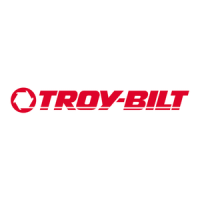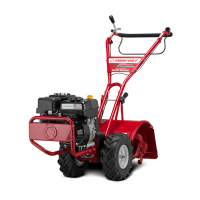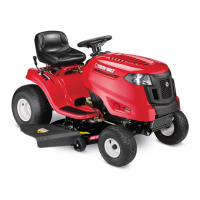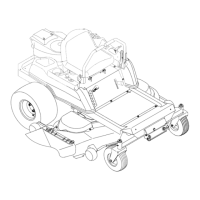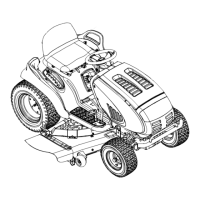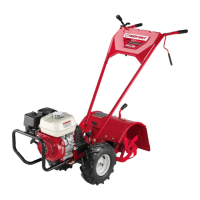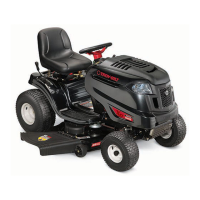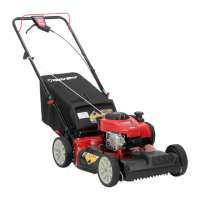22
SERVICE AND MAINTENANCE
NOTE: Using a pressure washer or garden hose is not
recommended for cleaning your tractor other than to clean
the underside of the deck. It may cause damage to electrical
components, spindles, pulleys, bearings, or the engine. The use of
water will result in shortened life and reduce serviceability.
• Clean under the hood, including exhaust manifold, around
fuses, all wiring and harnesses, muffler pipe, muffler shield,
engine intake screens and cooling fins, etc. See Figure 22.
Figure 22
• Clean the top of the tractor deck, under the spindle covers,
and belt area. See Figure 23.
Figure 23
• Clean around and near the transmission, axle and the fan
area. See Figure 24.
Wheel Not Shown For Clarity
Figure 24
• Debris can accumulate anywhere on the tractor, especially
on horizontal surfaces. Additional cleaning may be necessary
when mowing in dry conditions or when mulching.
• Fuel leaks/spills, oil leaks/spills, and excess lubrication can
also become collection sites for debris. Immediate repair and
cleaning up oil or fuel spills can help reduce fire hazards.
• In addition to cleaning the tractor before operating and
storing, do not attempt to mow unusually tall grass, 10” (25
cm) or higher, dry grass (e.g., pasture) or piles of dry leaves. Dry
grass or leaves may contact the engine exhaust and/or build up
on the tractor deck presenting a potential fire hazard.
Storing the Tractor
• Allow the tractor to cool at least five minutes in an open area
before storing.
• Do not park the tractor near any flammable materials (wood,
cloth, or chemicals) or any open flames or other potential
source of ignition (furnace, water heater or any other type
of heater).
• Remove all combustible materials from the tractor before
storing. Empty cargo boxes, grass catchers or containers.
• Always shut off fuel flow when storing or transporting if
tractor is equipped with a fuel shutoff.
• Check the fuel system (lines, tank, cap and fittings)
frequently for cracks or leaks. Repair and clean as necessary.
Maintenance
ENGINE
WARNING
Allow machine to cool in an open area for at least five
minutes before storing or refueling.
Refer to the Engine Operator’s Manual for all engine issues
and questions.
NOTE: Maintenance, repair or replacement of the emission control
devices and systems which are being done at owner’s expense may
be performed by any engine repair establishment or individual.
Warranty repairs must be performed by an authorized dealer.
CHANGING ENGINE OIL
WARNING
If the engine has been recently run, the engine, muffler and
surrounding metal surfaces will be hot and can cause burns
to the skin. Let the engine cool for at least five minutes.
Exercise caution to avoid burns.
OIL DRAIN TUBE MODELS
NOTE: The oil filter should be changed at every oil change interval.
To complete the oil change, proceed as follows:
1. Run the engine for a short time to warm the engine oil. The
oil will flow more freely and carry away more impurities. Use
care to avoid burns from hot oil.
2. Open the tractor’s hood and locate the oil drain port on the
side of the engine.
